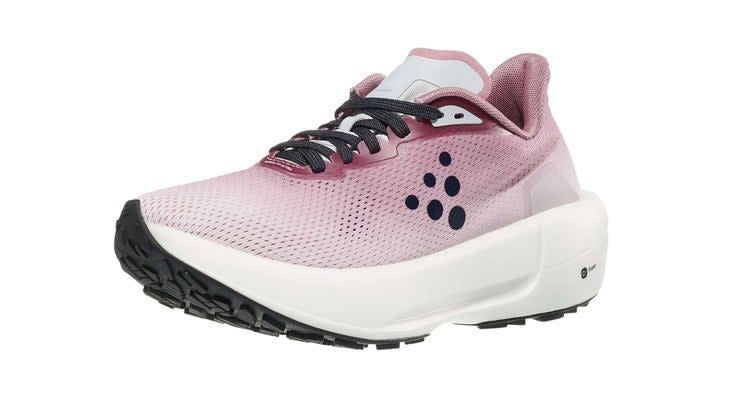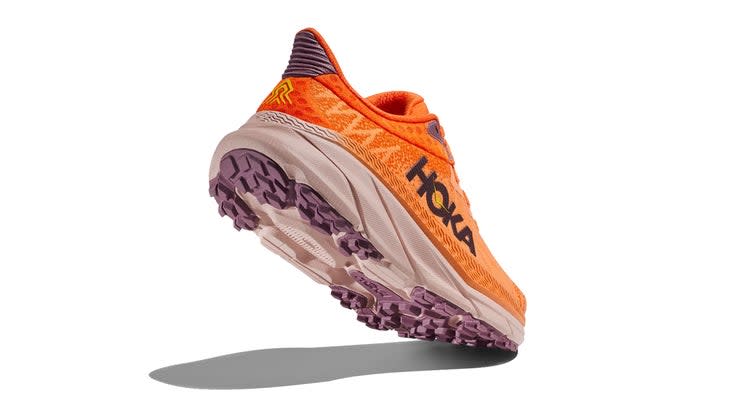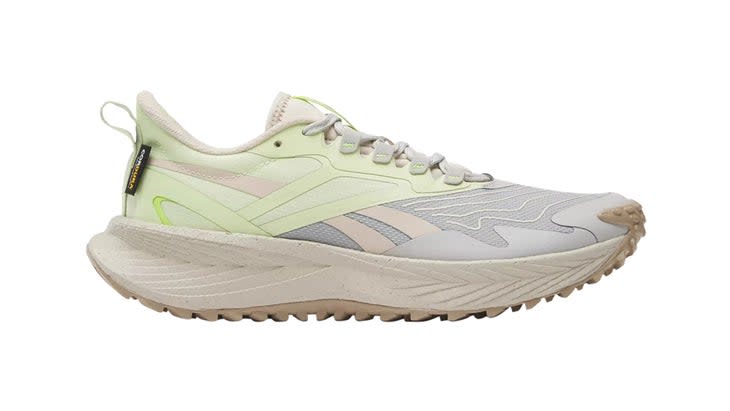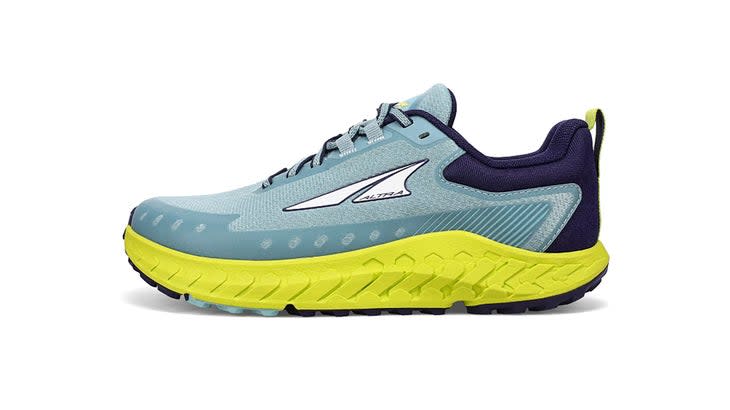4 Favorite Road-to-Trail Running Shoes
This article originally appeared on Outside
My favorite neighborhood running loop in my hometown of Boulder, Colorado makes choosing a pair of shoes a challenge. The route starts with a walk down a sidewalk past a few houses to a path that cuts through the middle of a community garden. There, I run across wood chips, weeds, and hard dirt, hit another sidewalk, and run concrete for about a mile, crossing two busy streets. At mile 1.3, I turn onto a rocky singletrack through tall grasses up, and then down, a very steep, loose, rocky hill with a killer view of the Flatirons. After negotiating a very narrow, windy strip of dirt next to a sidewalk, I cross a paved street, then run a tight singletrack through grassland over uneven ground that climbs gradually, then steeply to the high point of my run. I descend on a dirt fire road riddled with rocks and ruts that ends with steep wooden steps at the bottom, then make my way home on pavement and concrete sidewalks.
For this kind of run, I need a shoe that can handle every kind of terrain. A straight-up road running shoe with its cushioning and flexibility would help me maintain a smooth stride on the paved sections, but it would lack traction, protection, and security on the trail segments. A trail-specific shoe, on the other hand, would keep me feeling sure-footed and secure on the rugged dirt sections but would feel clunky on the road.
And the kind of dirt I run on this loop (and many other road-to-trail routes) is not smooth, mild, crushed gravel; it's more rugged than that, with rocks and ruts I can trip over, uneven landings, and loose dirt underfoot. I need a shoe that has lugs that grip and an upper that secures my foot in place. I don't want my foot sloshing around on a technical trail, especially up- or downhill.
I want it all: a well-cushioned shoe, with traction that doesn't clunk on roads but that makes me surefooted on dirt, and that keeps my foot secure and comfortable. And I want that shoe to be "runnable"--flexible like a road shoe, not stiff like a hiking shoe. It's a Goldilocks conundrum that has recently been solved by a somewhat burgeoning category of running shoes: the road-to-trail shoe.
I’ve researched, tested, and written about running shoes for numerous publications over the past decade and a half. After running in the majority of new running shoe releases this year, and testing all candidates for road-to-trail honors on my neighborhood loop and other mixed-terrain routes, here are my two favorite road-to-trail shoes currently on the market, plus two honorable mentions.
Craft Nordlite Ultra ($160)

An ample amount of responsive cushioning (40mm under the heel and 34mm under the forefoot) helps this shoe feel great on hard surfaces, both roads and super-firm Colorado dirt. The mid- and outsole are decoupled between the heel and forefoot, allowing each segment to move slightly independently, which I find works great on rocky terrain and pavement alike. It's flexible for smooth running on roads and gives me agility on the trails as it morphs around rocks, delivering a unique ride that I really enjoy. The outsole's 3.5mm lugs--some smaller, some larger--do a great job of grabbing loose surfaces and rock while not being so deep that they feel cumbersome on roads. The one-piece mesh upper is comfortable, but I sometimes crave a bit more support/foothold on technical trail sections. Overall, this is currently my favorite shoe for runs on varied terrain. 9.3 ounces (men's), 8.1 ounces (women's); 6mm offset
Best for: Those who like a flexible sole with substantial cushioning; those interested in trying a slightly decoupled midsole.
Hoka Challenger ATR 7 ($145)

This seventh iteration of the Challenger ATR looks more like the brand's rugged trail models than the mild-mannered Challengers of the past. The four-millimeter lugs are smaller in the center of the outsole and larger around the perimeter (a strategy inspired by gravel bike tires that lets the shoe both roll over roads and dig into dirt), and the new outsole rubber does a better job on technical terrain than previous versions of this shoe. There's more cushioning than in earlier versions, too (31mm/26mm of midsole foam for men, 29mm/24mm for women). The signature Hoka cush runs more like a monster truck than a ninja: it lets me just roll over rocks instead of picking my way around them. I like floating over roads and trails rather than pounding, so I reach for these when I want to zone out and not think about every foot placement on the trail sections, but I don't always feel like my weight is engaging the massive amounts of cushioning as much as I'd like. The shoe seems well-suited to heavier runners who can really make the most of all that midsole. It's not the most flexible shoe, but it is inherently stable, comfortable, and capable. 8.9 ounces (men's), 7.3 ounces (women's); 5mm offset
Best for: Hoka devotees, those seeking max cush, heavier runners.
Honorable Mention
Reebok Floatride Energy 5 Adventure ($120)

The Floatride Energy 5 Adventure runs smoothly on roads, likely encouraged by the significantly beveled heel shape, and feels decently cushioned (though, at 29mm/19mm stack height, not as cushy as the two favorites in this roundup). The lower-than-some midsole height, however, helps this shoe provide a solid, tactile, agile experience on the trail sections of my loop, and they feel relatively lightweight on all surfaces, which I particularly appreciate on the climbs. The traction--that extends almost along the entire bottom of the shoe, minus a small, diamond-shaped cutout in the EVA--did well on trails, both uphill and down. I appreciated the secure foothold of the upper (a durable Cordura) which adds to the agile ride. Because of its secure foothold and somewhat firm feel underfoot, this shoe also works well for me in the gym for lifting weights and doing body weight exercises. A downside: I experienced a strange and somewhat uncomfortable buckling across the top of my forefoot when the shoe flexed, which I think will soften up and dissipate over time, but which relegated this shoe to honorable mention. 10.4 ounces (men's), 8.5 ounces (women's); 8mm offset
Best for: Lighter runners, those looking for a reasonably priced, one-quiver shoe.
Altra Outroad 2 ($120)

Since I mostly run in shoes with at least a four-millimeter drop, I get a little nervous when I wear zero-drop shoes. I always tell people to ease into zero-drop shoes by walking in them first, then running short distances before hitting their regular stride and running their regular loops. When I run my loop in this shoe, I focus on landing midfoot instead of my usual heel strike--which feels prancy but efficient. Despite the concern, I was comfortable running in these shoes, and only felt a little niggle in my calf and heel on one foot after one run (which I'm not certain is from the zero-drop geometry). The Outroad 2 has the most aggressive traction of the four shoes in this roundup, spanning the full length of the outsole and providing great grip on all natural surfaces while not clunking too heavily on road sections The "Slim FootShape Fit" is classic Altra with its wide toe box, but with a narrower feel than others in the line, which works for my slim foot. And because of the balanced stance of the zero-drop sole and moderate height (27mm), this shoe worked for lifting weights, too. I tested the "Bravey" edition, designed in conjunction with pro runner Alexi Pappas, and got two compliments (on one run) on the blingy gold laces. 10.7 ounces (men's), 8.7 ounces (women's); 0mm offset
Best for: Zero-drop devotees or the curious looking for a nimble, balanced ride, runners looking to work on form.
For exclusive access to all of our fitness, gear, adventure, and travel stories, plus discounts on trips, events, and gear, sign up for Outside+ today.

